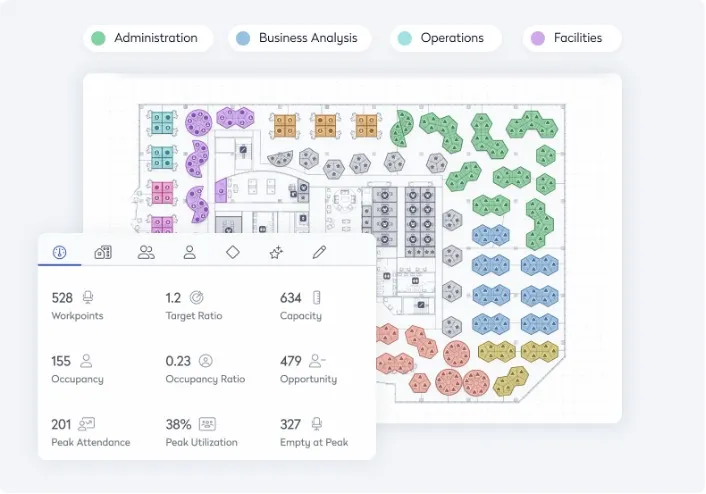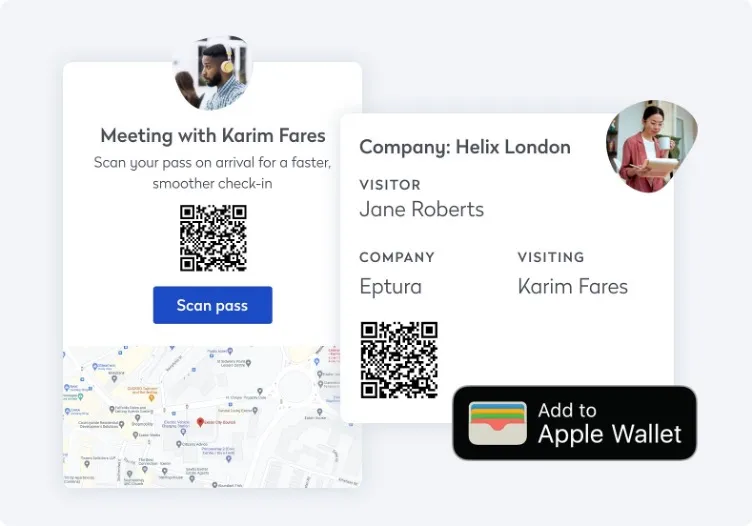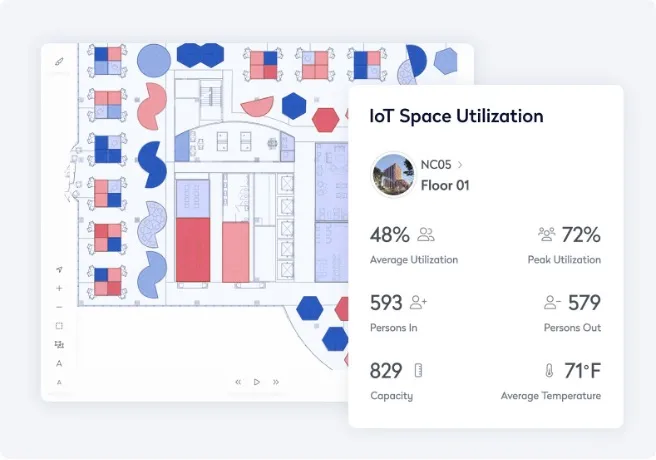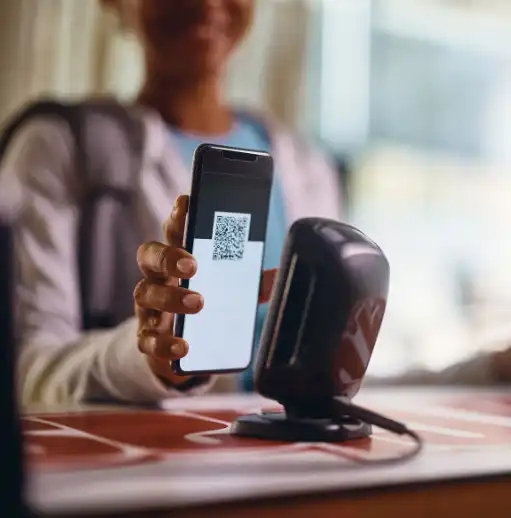
From our cars to our smartwatches to door monitoring systems in our homes, sensors are now part of our everyday lives. Increasingly, sensors have become part of our workplace experience too.
Think of them like a friendly ticket taker, keeping tabs on people flows and reporting metrics about buildings and systems, meeting room occupancy, temperatures, air quality, and more. Many advanced organizations are integrating data from sensors within their building automation systems and heating, ventilation, and air conditioning (HVAC) and lighting systems to save on energy costs and help hit corporate sustainability targets.
In the era of hybrid work, where new work patterns are emerging, sensors have an important role in separating workspace and building data facts from fiction. According to JLL’s “Future of Work” survey, occupancy sensors are among the key technology organizations plan to adopt by 2025 — along with remote working solutions, automation systems, and environmental controls.
“Since it’s not a given that the office will be full every day, knowing the number of seats or working spaces is no longer sufficient to inform strategies,” reflects JLL in a post about early adopters. “It’s clear the future of work is more relationship oriented than ever before. Decision-makers need to know who is in the office, when, and how they are using it. So do their co-workers and collaborators.”
The challenge has always been twofold. First, how do you integrate sensors with a variety of siloed systems? And secondly, is your organization being precise enough with what it needs to know from sensors? Sensors are not the solution to every building and workplace challenge.
To help answer these challenges and better understand the evolution of sensors and sensor data today, we spoke with Eric Maxfield, Director of Product Management, who has been working in the integrated workplace management systems (IWMS) software industry for 17 years.

Eric, tell us about your background and what you do at Eptura?
I’ve been in various roles throughout the family that’s become Eptura. I have an undergraduate degree in electrical engineering with a specialty in biomedical engineering, so I did a lot of work with signals and systems.
I started with Archibus and specialized in visualization. I was familiar with computer-aided design (CAD), so I did some custom work and support for CAD integration floor plans which evolved into becoming a local expert in geographic information systems (GIS) integrations.
Then, Archibus acquired rights to a suite of environmental sustainability and risk management products, so I was tapped as a product owner for that whole suite of applications. And thus began my role in product management. It set the stage for where I am now in that there’s a whole lot of data in our space.
Tell us about your experience with sensors across your career evolution.
With Archibus, my team focused primarily on energy meters and other utility and environmental sensors, while the space management product team explored occupancy sensors. With sensors, there’s always the technical challenge of collecting and integrating data, yet the bigger challenge as a product leader was helping think through how to make useful sense of the collected data to solve meaningful problems for customers.
How do we aggregate the various energy sources in buildings? Computing greenhouse gases is complicated. There’s a lot of math going on, many disparate things that roll together that our stakeholders really wanted to see. And you want to be able to boil the variety of metrics down to one number, but there’s a lot of nuance. How do you make recommendations with this kind of complexity?
So, part of the focus was helping facilities directors make more strategic decisions. During this period, I did a lot of analytics. And along that journey, the evolution of sensors went from being strictly tactical data to becoming more strategically valuable with the use of smarter data.

After Archibus and Serraview were acquired by JMI, we had new product leadership who wanted to start a brand-new analytics framework. So, I had the huge privilege to start another ground-up product innovation in a mature company.
I ran our little skunkworks startup shop for a while using the best tools on the market. We were able to work on innovative ideas for our customers which turned into a robust and comprehensive workplace analytics solution for Serraview. Modern dashboards and self-service functions with a lot of focus on space allocation and utilization metrics.
The real crux was utilization of the workplace because, at the time, offices in busy urban hubs were just stuffed to the gills. The concern then was, ‘how many more people can we get into our space’? What is the threshold for occupancy at which deciding there’s a hard stop for fire codes?
People get frustrated if they can’t find a seat they want or a meeting room. Job demand was so high in some of these urban hubs that there was a lot of churn in employees. It wasn’t just a space thing, but it was really an HR and a productivity concern.
Any other considerations when it comes to better managing space for facilities managers vis-a-viz sensors?
Well, there’s also the cost, right? Cost per square meter is high and you want to maximize it. You don’t want to have spaces sitting idle. Clients are really pouring over their data and their metrics. Common questions we’d get included: ‘How many people should we allow to book? How many of those on average cancel? They were asking: What’s the practical threshold for functional occupancy?
Badge data gave us a solid history of how many people entered a building. In some cases, buildings occupancy flirted daily with fire code limits, but by that point, most facilities feel beyond ‘bustling’ and were crowded to a disruptive level.
Today, organizations are experimenting with different workplace policies and configurations to support the modern models of agile, flexible, hybrid work. The workplace has become more self-directed which compounds the complexity. And so, there’s a real need and hunger for analytics and accuracy in data now – and sensors are a valuable tool for gathering movement and flow data once people are inside buildings – and for helping us understand behavior in spaces of all kinds.
There are a ton of variables because buildings and workspaces involve humans. The facility itself can be complicated, but human behaviors are much more difficult to predict, So, workplace and building analytics are exciting areas to analyze and extract value from … That was the impetus and the challenges with Serraview, but as we built it, we thought, we’re going to end up having other companies involved and other solutions. So, let’s build this for integration with other products.
Along comes Thoma Bravo and now we’ve become Eptura. Today, we have a panoply of products with customers with similar problems they’re trying to tackle with different technologies. It’s led to a revised decision on what technology should we use and standardize on so that we deliver the best-in-class analytic solution for workplace and asset management.
That’s the journey we’ve been on lately and it’s exciting to have an ever-growing and expert team with different perspectives to work with daily.
“You know sensors in isolation provide good info, but sensors connected to workplace assignments and neighborhoods, together with badge, access control, and booking data. If you’ve got that, now we start multiplying the benefits. Now we can start to see patterns, behaviors, and interactions a lot more. That helps us make smarter decisions.”
How has the role of data evolved in facility and space management in your time?
It’s evolved a lot. The general evolution has moved from specific operational functions towards higher level strategic analysis. In a traditional workplace where there was one-to-one [desk] assignments, you needed a name and the location. You needed to provide a function to a person. Data was used just to track those decisions and have a reference point.
The evolution has been from operational data to more strategic data. And its evolution and the interest has always been there. I think the evolution has been helped by the ease of sharing data today.
The technology itself has truly evolved. Certainly, the cloud has helped. It’s so much easier to get data with the advent of the modern data warehouse, for example, so much has come along, including sensors, that have made it easier to deliver data in aggregate.
We analyze our global data quarterly. See our findings based on analysis of 2.7 million desks, 37,000 buildings, and 440,000 floors across more than 8,000 companies.
Today, there is a lot going on in the entire building information ecosystem. Think about emergency management: You need to know who’s in the building. And, if you had a need for an evacuation, did everybody that was supposed to be in that day make it in? Worktech can help share this kind of data a lot easier than it used to be.
There’s also energy management today. Did we know how energy usage associated with a team’s allocated space and meeting room use rolls up to costs in the past? Typically, that was fuzzy. But with the evolution of workplace and building technology, including sensors, the integration is becoming more closely tied together than it’s ever been. So, it’s becoming less fuzzy to gain insights from data. The more metrics are tied to costs, the happier senior stakeholders are because they can trust the numbers more. Today, data allows for more predictability between costs and the effects of building utilization.
What does it cost to operate this building? What does it cost per head count in this building? How many people can we put in our workspaces before it starts tipping towards being overcrowded? How can we best adapt our strategy at a broader level to support rather than frustrate our occupants’ collaboration?
Now, everything gets poured into the same data warehouse and you can get the totals with a quick click of the button. That’s just having it available. But since it’s available now, we can do more interesting things with it, and we can see other relationships related to what was once a siloed set of data managed and used by one siloed set of the organization together with another set of data. It’s now much richer. And data is more transparent. You can have defensible relationships clearly defined, and then see how things affect one another or do not, so that you can collectively make better decisions.
So that’s evolution. Modern data analytics summaries and dashboards.
But it’s even further now that there is more sophisticated statistical analysis, and other enrichment of data. Today, you can model in algorithms in a smart way, so that we may train a machine to look for patterns and make suggestions. We can feed data insights back into the system and create feedback loops.

So, would you say we’ve been able to get to a place of more precision with data captured with sensors and other building systems as it’s evolved?
In general, yes, but not everywhere. It depends on how you define precision. We can collect data digitally and that’s a lot more reliable than anecdotal data, and it’s of higher granularity which typically corresponds with precision.
Look at headcounts in a building. I remember when people would hire teams to just walk the floors and tick off headcounts. Maybe they had a security system or a turnstile.
Now, it’s a badge swipe or card access, tied to an access-control based visitor management system, and you get an automatic log of everybody in the building. You know who’s in the building. But with sensors you can take it further to isolate a specific count of people on a given floor as people walk by different technologies.
Plus, there are more advanced ways of Wi-Fi integration or IP access where we’re identifying the person, where they’re connected, and their degree of activity. It’s more precise and concrete in that sense with less estimating which adds many more opportunities for enrichment.

Can you speak about the role sensors are playing today and in space management and utilization, and how has it evolved over the last decade?
It’s grown in adoption. The cost of the hardware and implementation has reduced dramatically. The ease of integrating the outputs is also better. It was a novel thing and there were certain high-tech workplaces that would have it. But there’s also been an evolution of expectations. Most organizations want to have a wired up modern workplace. There’s a value in and of itself, you know, it attracts people, it’s cool, and you can be a frontrunner in a lot of ways.
It’s becoming more of a commodity, so organizations are asking what’s the value we’re trying to achieve with our buildings and workspaces. What’s the cost benefit?
It’s easy to overpromise with sensors too though … Putting in sensors won’t tell you everything. There are a lot of positive values you can derive from sensors, and many workplaces are finding it. I think we’ve seen more maturity and understanding on the priority of different use cases. So, if we want to do strict headcount that might be useful.
But is it as valuable to have a sensor on every specific desk, especially where we have flexible seating? Is that as useful as sensors in the meeting room to provide headcount where it’s a shared space and it’s a little bit more premium aspect of our facility. Will it be more costly to reconfigure our space? Deploy sensors to help find answers to gaps in your knowledge, especially in areas that are harder to figure out.
It’s significant. And I think another evolution goes with the overall data world: You know sensors in isolation provide good info, but sensors connected to workplace assignments and neighborhoods, together with badge, access control, and booking data. If you’ve got that, now we start multiplying the benefits. Now we can start to see patterns, behaviors, and interactions a lot more. That helps us make smarter decisions. With sensors, we’re able to see more than just static desks, meeting rooms, static auditoriums, static badge data.
You see which spaces are getting the most use: Look at this type of breakout space versus that type of breakout space configuration. Everybody loves this one and nobody seems to show up at the other one. Well, let’s ditch that config and go to the other one.
“Sensors can help you make more confident decisions which may be well worth the investment. A one floor reconfiguration or non-reconfiguration could be well worth the cost of deploying sensors for cost avoidance or appropriate cost investment.”
What are some of the best practices in implementing and using sensors?
I would recommend that a client look at the high-level data first and decide which locations or areas to deploy sensors. Decide what question they want answered. Prioritize.
For example, let’s say we have a few buildings that are jammed full. You don’t know how best to reconfigure them, or you have only one office building which is high intensity, or this is the building where everybody loves to work. What is it about that building? What can we learn about? So, you want to study it more. Perhaps you have two different kinds of teams, sales on one floor, accounting on another, and developers on another.
How are they using their space generally? What are the occupancy patterns? Perhaps you’ve heard anecdotal complaints, how no one can even book a meeting room. Is that really the case or are they just not looking that hard or is the space is too small?
Do we or do we not have enough information to right size? That’s a common question and one of the first ones to go after. Questions to start:
- Look at the high-level data and ask: Where do I have gaps in your knowledge?
- Where do I want to plug in those gaps?
- Use sensors in these areas
The other thing to know is what sensors can’t tell you. They’re not going to tell you ‘Who’. If somebody’s running really fast down the hallway and tripping a bunch of sensors off, is it five people or is it just one person who ran past? The main thing is anonymity. You have to make some inferences about who’s using a space or bring in other data sets.
Start with the question and the value, and then look at what sensors can’t answer and go from there. If you see success, that is great. Let’s roll them out elsewhere and keep evolving the strategy rather than biting off sensors across the entire globe from the outset and invest in a major project.
Do you think artificial intelligence (AI) will play a role in the evolution of sensors in the larger context of space planning and the future?
Yes. I mean there’s a lot we know to look at already. We get a lot of interest. We’re planning to employ it in a variety of ways, especially with space planning and sensors. We’re looking at its potential to help recognize patterns and find unexpected correlations.
There are some things that we know to look for already and we do them. We write algorithms to dig into those efficiently. But it’s using AI to find unexpected things that might percolate amid the many different optimizations.
The goal is to use AI and machine learning (ML) to isolate and declutter insights because everyone is drowning in data. That’s another evolution right. Used to be, ‘Oh, I can’t get data.’ Well, then it turned into I have too much. And so now we need to make sense of it and find what is meaningful.
It’s not magic. AI and ML can be effective tools to help us sift through the piles of data that come at us. But we still need to be smart about things and provide real intelligence to it. But it can augment our overall solution and other sources too.
“Sensors can help you make more confident decisions which may be well worth the investment. A one floor reconfiguration or non-reconfiguration could be well worth the cost of deploying sensors for cost avoidance or appropriate cost investment.”
For example, what do outside factors influence the workplace? What are occupancy patterns by different personalities? For example, could the weather affect occupancy rates? Does good weather mean people call in sick and tend to not be in the office? Or does good weather mean they feel good about coming in? Will they go to work on a nice day as opposed to a rainy day? Nothing new to do around the house. I might just go to the office and see some people that’ll cheer me up.
ML could help identify behavioral patterns which then could have many applications for space planning and human resources programs.
On the asset side, AI and ML could help with patterns for preventive maintenance schedules. How often do things break and wear out or need to be serviced based on occupancy? Since the occupancy loads are hard to predict, how often are we fixing specific systems? How much cleaning services do we need? Are we better off renovating space?
Any specific skills that facility managers or workplace strategists need to learn to become more proficient in interpreting data from sensors?
It’s about understanding what they do and do not tell you. Plus, you’ll need to understand a bit of statistics and math. You’ll want to know what’s anomalous activity and what’s high variance from the norm.
And you need to have some awareness of how different dashboards and metrics tools work, and the different kinds of sensors that you are using and how they capture information. If your organization has its own business intelligence tool, do you want to integrate it with sensor data and dashboards?
Also, being aware of what the human response will be to using this technology is important. Because it’s not that you want data, but you’re serving these people, so the technology of the workplace needs to be non-intrusive, non-threatening, and supportive. There’s change management here with something like sensors.
You need to communicate the benefits to the occupants. Say there was feedback about the lack of sufficient meeting rooms. You’d want to explain what you were doing in a sensor study and share the results.
On the data side, we’re hoping to make it easy. Eptura is in contact with so many practicing experts. We keep conversations going with our customers, their facilities managers and space planners, because we’re always learning new questions and new ways. Our goal is to give you data recommendations so that you don’t have to think about it so much. The end goal is to provide decision support and decision recommendations, so you don’t have to be a statistical analyst or data scientist to get value out of the product.

Is there anything else on the horizon for data and sensors you think worthy of pointing out or keeping an eye on?
Well, one of the areas specific to Eptura is Serraview Live (SV Live). It provides some special benefits over and above ordinary sensors in that it’s personally identifiable, still anonymized, so you can know that a specific person is there using the network.
It’s a different kind of integration. From a data standpoint, it’s a very useful data set in that it tells who’s there and their activity level. Is somebody at the desk? Are they plugged in? A sensor will tell you if somebody’s actively there, but it’s not going to say they’re still plugged in, that they went to go meet with somebody somewhere else, or if their desk is available.
There are a lot of different behavioral things you can pick up from having the personal info. A sensor provides a hard count. It tells you if someone’s there or if someone’s not there.
If you’re using Wi-Fi to detect person presence, there’s somewhere within the signal range that’s reasonably accurate at times. But you know, you might be standing and leaning on the wall outside the conference room sipping coffee, having a chat with somebody. Whether or not they are in the room, that that gets harder to pinpoint sometimes. A sensor can be very definitive in that sense.
Again, it depends on the issues customers are having. We’re still at an emerging time in terms of the new workplace and occupancy levels. So, the questions I’m seeing aren’t as much about how many more people customers can put into buildings and workspaces.
Sensors’ role might be a little different in this landscape. In the short term, the meeting room use case is an interesting one. Because one of the reasons to come into the building now versus staying at home and working from home is to meet with people. Meeting room usage is a good indicator of that kind of collaboration. Sensors, when connected with space planning systems, allow you to make interpretations from it.
Eric Maxfield, Director of Product Management, Eptura
Eric has 17 years of experience in technical and product management capacities with leading integrated workplace management systems (IWMS) software companies, to deliver solutions for facilities and asset management, space planning, and risk management and environmental sustainability to customers in a wide variety of industries. He draws on his degrees in electrical engineering and graduate research in humanities disciplines as he leads teams focused on data analytics and visualization to support stakeholders’ strategic decisions and workplace optimization. He currently lives in western Michigan in the US.








